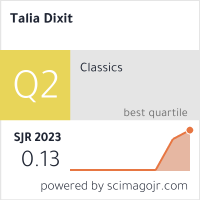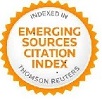Jenofonte de Éfeso: ornato retórico en las Efesíacas
Palabras clave:
Jenofonte de Éfeso, novela, retórica, epitomización, monólogoResumen
La novela de Jenofonte de Éfeso ha recibido atención por diversas razones, pero no precisamente por su empleo de un estilo tocado por un color retórico. Al contrario, se ha llegado a señalar que el autor no era capaz de utilizar este tipo de registro. El presente trabajo presenta, a pesar del carácter del texto que para muchos estudiosos es sólo una versión epitomizada del original, evidencias de que la retórica sí ha de contarse entre los elementos característicos de la novela.
Descargas
Referencias
BERRANGER-AUSERVE, D. (2006), “Dialogues et débats dans les Éphésiaques de Xénophon d’Éphèse”, en B. Pouderon y J. Peigney (eds.), Discours et débats dans l’ancien roman, Actes du Colloque de Tours, 21-23 octobre 2004, Lyon: Maison de l’Orient et de la Méditerranée, pp. 15-26.
BILLAULT, A. (1991), La Création romanesque dans la littérature grecque à l’époque impériale, Paris: Presses Universitaires de France.
BOWIE, E. (2002), “The Chronology of the Greek Novel since B.E. Berry: revisions and precisions”, Ancient Narrative, 2: 47-63.
BÜRGER, K. (1892), “Zu Xenophon von Ephesus”, Hermes, 27: 36-67.
CAMPS GASET, M. (2017), “Theatrical Background in Xenophon's Ephesiaca”, Quaderns Catalans de Cultura Clàssica, 33: 25-36.
DALMEYDA, G. (1962), Xénophon d’Éphèse. Les Éphésiaques, Paris: Les Belles Lettres.
DE TEMMERMANN, K. (2014), Crafting Characters: Heroes and Heroines in the Ancient Greek Novel, Oxford: Oxford University Press.
DENNISTON, J.D. (1934), The Greek Particles, Oxford: Clarendon Press.
DODDS, E.R. (1960), Euripides Bacchae, Oxford: Clarendon Press.
DOULAMIS, K. (2007), “Stoic Echoes and Style in Xenophon of Ephesus”, en J.R. Morgan y M. Jones (eds.), Philosophical Presences in the Ancient Novel. Ancient Narrative. Suppl. 10, Groningen: Barkhuis, pp. 151-175.
FUSILLO, M. (1988), “Textual patterns and narrative situations in the Greek Novel”, en M. Hoffmann (ed.), Groningen Colloquia on the Novel, Groningen, pp. 17-32.
GRIMAL, P. (1963), Romans grecs et latins, Paris: Gallimard.
HÄGG, T. (1971), Narrative Technique in Ancient Greek Romances. Studies on Chariton, Xenophon Ephesius, and Achilles Tatius, Uppsala: Almqvist & Wiksell.
HÄGG, T. (20042), “The Ephesiaca of Xenophon Ephesius – Original or Epitome?”, en T. Eide y L.B. Mortensen (eds.), Parthenope: Selected Studies in Ancient Greek Fiction (1969-2004), Copenhagen: Museum Tusculanum Press, 159-198.
HOAG, G.G. (2013), The Teachings on Riches in 1 Timothy in Light of Ephesiaca by Xenophon of Ephesus, PhD. Diss., University of Bristol.
HOGAN, D.K. (2006), Forensic Speeches in Acts 22-26 in their Literary Environment: A Rhetorical Study, PhD. Diss., Baylor University.
KERÉNYI, K. (1971), Der Antike Roman: Einführung und Textauswahl, Darmstadt: Wissenschaftliche Buchgesellschaft.
KÖNIG, J. (2007), “Orality and Authority in Xenophon of Ephesus”, en V. Rimell (ed.), Seeing Tongues, Hearing Scripts: Orality and Representation in the Ancient Novel, Groningen: Barkhuis, pp. 1-22.
KYTZLER, B. (1996), “Xenophon of Ephesus”, en G.L. Schmeling (ed.), The Novel in the Ancient World, Leiden: Brill, pp. 336-360.
LAVAGNINI, B. (1922), “Le origini del romanzo greco”, Annali della Scuola Normale Superiore di Pisa, 28: 9-104 (repr. in H. Gärtner (ed.) (1984), Beiträge zum griechischen Liebesroman, Hildesheim, pp. 68-101).
LESKY, A. (1989), Historia de la literatura griega, Madrid: Gredos.
LOBEL, E. – PAGE, D.L. (1955), Poetarum lesbiorum fragmenta, Oxford: Clarendon Press.
LÓPEZ JORDÁN, L.J. (1999), Estudios sobre el vocabulario de las Efesíacas de Jenofonte de Éfeso, Tesis Doctoral, Universidad de Murcia.
MERKELBACH, R. (1962), Roman und Mysterium in der Antike, Munich: Beck.
NERI, C. (2004), La lirica greca. Temi e testi, Roma: Carocci.
O’SULLIVAN, J.N. (1995), Xenophon of Ephesus. His Compositional Technique and the Birth of the Novel, Berlin: De Gruyter.
O’SULLIVAN, J.N. (2005), Xenophon Ephesius. De Anthia et Habrocome Ephesiacorum libri V, (Bibliotheca scriptorum Graecorum et Romanorum Teubneriana), Monachii et Lipsiae: K.G. Saur.
PAPANIKOLAOU, A.D. (1973), Xenophon Ephesius. Ephesiacorum libri V: de amoribus Anthiae et Abrocomae, Leipzig: Teubner Verlagsgesellschaft.
PERDICOYIANNI-PALÉOLOGOU, H. (2002), “The Interjections in Greek Tragedy”, Quaderni Urbinati di Cultura Classica, 70: 49-88.
POMER MONFERRER, J.J. (2015), Aticisme i koiné als llibres I-III de les Etiòpiques d’Heliodor, tes. doc., Universitat de València.
RATTENBURY, R.M. (1950), “Review of R. Helm, Der antike Roman. Berlin: Wissenschaftliche Editionsgesellschaft, 1948”, Gnomon, 22: 74-77.
REARDON, B.P. (1991), The Form of Greek Romance, Princeton: Princeton University Press.
ROHDE, E. (1876), Der griechische Roman und seine Vorläufer, Leipzig: Breitkopf & Härtel.
RUIZ MONTERO, C. (1982), “Una interpretación del ‘estilo καί’ de Jenofonte de Éfeso”, Emerita, 50: 305-323.
RUIZ MONTERO, C. (1994), “Xenophon von Ephesus: ein Überblick”, Aufstieg und Niedergang der römischen Welt, II 34.2: 1088-1138.
RUIZ MONTERO, C. (2003a), “Xenophon of Ephesus and Orality in the Roman Empire”, Ancient Narrative, 3: 43-62.
RUIZ MONTERO, C. (2003b), “Aspetti dello stile della narrativa popolare greca”, Lexis, 21: 81-99.
RUIZ MONTERO, C. (2006), La novela griega, Madrid: Síntesis.
TAGLIABUE, A. (2017), Xenophon’s Ephesiaca. A paraliterary love-story from the Ancient World, Groningen: Barkhuis.
VOIGT, E.-M. (1971), Sappho et Alcaeus. Fragmenta, Amsterdam: Polak & van Gennep.
WHITMARSH, T. (2011), Narrative and Identity in the Ancient Greek Novel: Returning Romance, Cambridge: Cambridge University Press.












